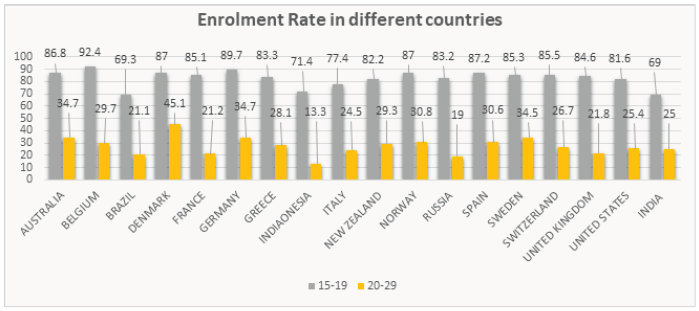Career counselling is much required in these countries to improve the job scenario and thus the economy.
It has been recommended by the American School Counsellor Association that the student to counsellor ratio should be 250:1 for the ideal education economy. However, this condition is met by very few states across the world.
Even the USA, which is a developed nation, has an average country-wise ratio of 491:1. In many countries, it is a common education issue that students do not understand the areas and career fields where they can excel.
Students are negligent towards their own strengths and weaknesses, and they take up a career based on:
- What their peers are selecting,
- What their parents suggest them to do
- At many times according to the potential salary they can get in a specific career.
They often end up in unsuitable career fields which decrease their motivation to complete their education.
Many students drop out of their schools and colleges due to reasons similar to the above stated. However, a proper career counselling session combined with psychometric assessment can help the students to understand their skills and talents and use them in a specified career field to ensure success.
Case Study: Denmark
It is a matter of great consideration that educational and vocational guidance is one of the highest priority in Denmark. There is a Danish Act on career guidance which ensures easy and free access to all the residents of the country to a quality career guidance program.
The government has introduced three kinds of access to the people of Denmark- Youth Guidance Centres, Regional Guidance Centres and eGuidance Centres.

In addition, adult education is given a good share of importance since the government believes that learning is a life-long process, and it is required to keep improving the skills for employment. Thus, not surprisingly, the results are evident in the enrolment ratio as well.
Considering the enrolment rate of above mentioned 17 countries, it is clear that the enrolment rate of the age group 15-19 is much more when compared to the age group of 20-29. The difference in enrolment rate of age group 15-19 and 20-29 is highest in Indonesia and the least in Denmark.
The difference is not surprising as the population of 20-29 constitutes the working or labour force in any country and 15-19 is more inclined towards education.
However, the surprising fact is that the older population in Denmark is highly focused on higher education as compared to other countries in the analysis. (Source- OECD)














